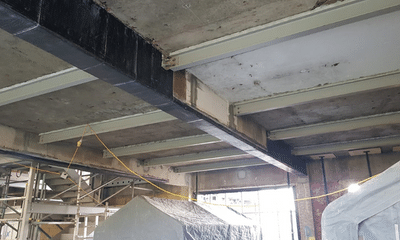Why we choose carbon fibre for structural strengthening every time, particularly for the rehabilitation of existing structures
At CCUK, structural strengthening – encompassing the repair, rehabilitation, and future-proofing of industrial architecture – is a specialism that our team has decades of experience in. Thus, over the years, we’ve worked with all calibres of specialist strengthening materials: from wood and aluminium to steel – and in more recent years, carbon fibre. It may not surprise you, but carbon fibre reinforced materials (FRPs) have come up trump! Continue reading to discover why our highly experienced team chooses carbon fibre for structural strengthening time and time again.
Why use carbon fibre for structural strengthening?
There is an abundance of reasons why carbon fibre is our no.1 choice for strengthening large, existing structures – particularly industrial buildings, bridges, warehouses, and pipelines, to name a few.
*Are you a carbon fibre newbie? Before reading about the vast pros of using carbon fibre, you might want to take a look at what carbon fibre is as a product here
Here are just some of the reasons we use carbon fibre for structural strengthening over other, alternative materials:
1. Carbon fibre is stronger than steel
“Is carbon fibre stronger than steel?” is a frequently asked question. Though lighter, more flexible, and more durable, carbon fibre *can be* up to 10 times stronger and significantly lighter than steel (2). This is providing the strength to weight ratio is balanced correctly, along with taking other details into account – like different tensile strength, compression strength, etc. (see the section of this blog on types of material strength and why they matter).
2. Carbon fibre strengthening doesn’t degrade in extreme conditions
This is a critical one – especially in our industry! Some structures we repair are submerged in water, some carry large volumes of liquid chemicals, while others are sky-high, standing out in the corrosive rain all day. When carrying out strengthening applications to these existing structures, we need to know that these materials when used correctly will fend off these conditions and resist degradation going forward.
3. Carbon fibre strengthening is low-maintenance after application
Once accurately installed by a trained contractor, carbon fibre typically lasts over 50 years before needing revision. That’s what we know so far about carbon fibre’s lifespan, anyway – new industry testing is being carried out all the time! The decent contractors among us will want your structural integrity to retain, rather than returning every decade or less to complete more repairs.
4. Carbon fibre can be repaired
“Can carbon fibre be repaired?” is another query frequently looked up. You’d be mistaken for thinking that because carbon fibre looks so slick and delicate, a break, crack, or void can’t be repaired. The truth is, if it’s designed and installed by professionals it shouldn’t need repair, but if it becomes damaged for any reason rehabilitated carbon fibre looks like new – so most people wouldn’t know it had ever suffered damage! Even the sturdiest concrete buildings have a lifeline and most require maintenance at some point, so it’s essential that the material we are using can be repaired if need be.
5. Carbon fibre is lightweight
…which is extremely useful when you are completing a strengthening job on a very large building or bridge, because it requires transporting heaps and heaps of material! By using featherlight carbon fibre, you can reduce manpower and heavy lifting equipment, construction programmes and thus, costs.
To learn more about the types of structures that respond well to carbon fibre applications, please skip to our blog: The Industrial Uses of Carbon Fibre Reinforced Polymer Applications | Composites Construction UK (fibrwrap-ccuk.com).
Our no.1 reason for choosing carbon fibre for structural strengthening
A hint can be found in the header… have you guessed it yet? Yes… the no.1 reason our highly trained contractors will always choose carbon fibre over other strengthening materials is because of its strength! But what do we mean by the word `strength`?
Types of material strength and why they matter
When it comes to material strength in large buildings and structures, we are looking for those that cope under everyday stresses and strains, including (but not limited to):
+ Corrosion caused by weathering and chemicals
+ Everyday wear & tear – we call this `wear resistance`
+ Excess and repetitive load-bearing
+ Exposure to heat
+ Potential fractures
A material’s ability to cope with these stresses and strains is not measured by strength in general, but by various types of strength. At CCUK, our specialist contractors have trained in looking out for these types of strength before opting to use material within a project (1), which include:
- Compressive strength: the total weight you can lay on top before crumbling, crushing, or compressing parts of a structure.
- Tensile strength: how much resistance it takes to pull areas of a structure apart or force it to expand.
- Ultimate strength: the capacity a structure reaches before it breaks from compressive and tensile forces combined.
- Elasticity: how easily elements `ping back` to their original form after being under compressive or tensile strain.
- Plasticity: how easily elements adapt to being deformed or changed without breaking.
- Yield strength: the measure of elasticity and plasticity within structural elements.
- Flexural strength: how easily the structural elements flex and bounce back, rather than bending and causing permanent deformities.
As you can see, the term `strength` covers lots of different qualities whilst we are talking about materials. Carbon fibre has high compressive, tensile, flexural, and therefore ultimate strength – along with possessing a great level of elasticity. The perfect concoction for a structural strengthening material, many may say!
Book your FREE feasibility study for carbon fibre strengthening today
As with every specialist service we offer, the first step is to contact us to book your FREE feasibility study and cost analysis (a fancy name for site visit and quote!). From here, you can ask all the questions you need and our specialists will get the opportunity to determine whether carbon fibre strengthening is a suitable solution for your project. There’s no obligation to go ahead, of course. To book a time and date that suits you, please call 01482 425250 or fill in our online form. We look forward to hearing from you!
Suggested reading for you based on carbon fibre for structural strengthening
Structural Strengthening and Repairs
Structural Strengthening brochure
Is Carbon Fibre a Sustainable Material for Strengthening Buildings and Structures?
The Do’s and Don’ts of Using Carbon Fibre Strengthening Materials
References:





